
The Key To Not Falling Goes Beyond Balancing On 1 Leg
➡️ You catch your toe on an uneven sidewalk.
➡️ You miss the last step on the stairs.
➡️ You step on a rock you didn't see and lose your balance.
➡️ You get tripped up by the dog.
Do you catch yourself or hit the ground?
These moments are reminders that balance is essential and often overlooked until it fails.
Balance involves your brain, inner ear, eyes, nervous system, muscles, and even your cardiovascular system. Good balance makes you feel capable of leading your most robust life safely and confidently.
Balance can change with age
The average 50-year-old can stand on one leg for about 40 seconds. By age 80, it’s down to 10 seconds.
Poor balance is a major red flag for injury risk. Falls are the leading cause of fatal injuries in older adults.
Over 1 in 3 adults over 65 fall each year!
Test Your Balance
Try standing on one leg with your eyes open. If you can hold it for at least 30 seconds, you’re in pretty good shape. Less than 10 seconds? You might have a serious fall risk.
What's the most effective way to improve balance?
Strength training!
Even better than balancing on 1 foot is moving on 1 foot.
Balancing on 1 foot becomes the equivalent of a circus trick.
Moving on 1 foot is functional--something we do all day every day.
That's why we do so many hinges, squats, and lunges on 1 leg.
Strength training is the single most effective approach to fall prevention. It has a multi-systemic effect, improving physical function, muscle mass, balance, bone mass, cognition, and posture.
Think about it--balance is easier when you're standing up straight!
Untrained folks need to progress from low to moderate intensity, but power-based strength training should also be incorporated because the ability to react powerfully is critical to prevent falls.
Strengthening muscles in the legs, hips, and core improves the ability to maintain balance and stability, significantly reducing the risk of falls.
Even better, it's efficient. Only 2-3 sessions a week yields dramatic improvement.
Challenge your body and brain.
People who fall more often have a smaller hippocampus (the brain region tied to navigation and memory) and may be at higher risk for cognitive decline.
Walk with friends: People have fewer falls when they’re good at multitasking. Even adults in their 30s begin to lose this capacity. Researchers found that some older adults needed to stop walking to focus on conversation. In subsequent years, the stop-to-talk group suffered significantly more falls than the walk-and-talk group.
Unpredictable movement: Try skipping and dancing.
Surface variations: Balance on soft carpet and grass.
Sports and mindful movement: Exercising or playing a sport reduced injurious falls by 20%
Bonus Tips
Keep your hearing and vision sharp. They're crucial to staying upright.
Be cautious with multifocal glasses when walking outdoors.
Improve mobility. Limber bodies react faster.
Whether you're looking to excel at golf in your 70s, hike mountains well into retirement, or simply avoid that late-night kitchen disaster with the open dishwasher door, maintaining good balance is an investment in your independence and quality of life for years to come.